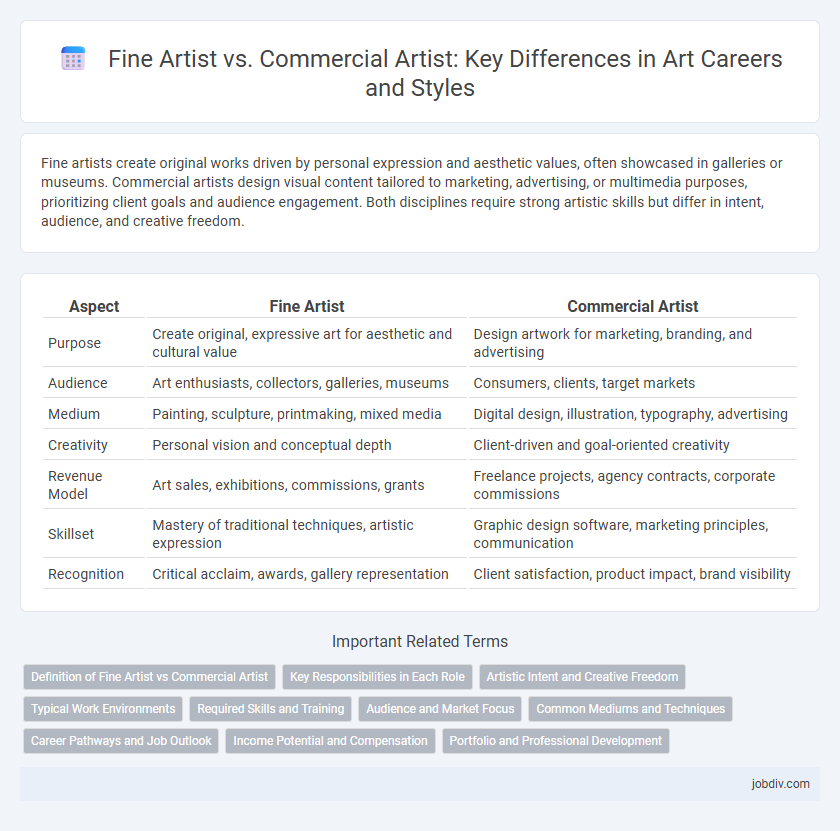Fine artists create original works driven by personal expression and aesthetic values, often showcased in galleries or museums. Commercial artists design visual content tailored to marketing, advertising, or multimedia purposes, prioritizing client goals and audience engagement. Both disciplines require strong artistic skills but differ in intent, audience, and creative freedom.
Table of Comparison
| Aspect | Fine Artist | Commercial Artist |
|---|---|---|
| Purpose | Create original, expressive art for aesthetic and cultural value | Design artwork for marketing, branding, and advertising |
| Audience | Art enthusiasts, collectors, galleries, museums | Consumers, clients, target markets |
| Medium | Painting, sculpture, printmaking, mixed media | Digital design, illustration, typography, advertising |
| Creativity | Personal vision and conceptual depth | Client-driven and goal-oriented creativity |
| Revenue Model | Art sales, exhibitions, commissions, grants | Freelance projects, agency contracts, corporate commissions |
| Skillset | Mastery of traditional techniques, artistic expression | Graphic design software, marketing principles, communication |
| Recognition | Critical acclaim, awards, gallery representation | Client satisfaction, product impact, brand visibility |
Definition of Fine Artist vs Commercial Artist
Fine artists create original works primarily for aesthetic expression and personal vision, often exhibited in galleries or museums. Commercial artists produce visual content designed to promote products, services, or brands, focusing on client requirements and market appeal. The fundamental difference lies in the purpose: fine art emphasizes creative expression while commercial art prioritizes communication and marketing goals.
Key Responsibilities in Each Role
Fine artists create original works that express personal vision and creativity, using mediums like painting, sculpture, and drawing for galleries, exhibitions, or private collections. Commercial artists focus on producing visual content tailored to client needs, including advertising, branding, and multimedia campaigns, often working within strict deadlines and guidelines. Both roles require strong artistic skills, but fine artists prioritize self-expression while commercial artists emphasize marketability and audience engagement.
Artistic Intent and Creative Freedom
Fine artists prioritize personal expression and creative freedom, often producing work that challenges norms and explores abstract concepts without concern for commercial appeal. Commercial artists focus on meeting client objectives and market demands, tailoring their creativity to promotional and advertising needs within defined guidelines. The artistic intent in fine art centers on individual vision and emotional impact, while in commercial art, it aligns with strategic communication and audience engagement.
Typical Work Environments
Fine artists typically work in private studios, art galleries, or personal home spaces, allowing creative freedom and individual expression. Commercial artists often operate within advertising agencies, design firms, or corporate studios, collaborating closely with clients to meet specific branding goals. Each environment influences the artist's workflow, resources, and creative process, distinguishing the independent nature of fine art from the client-driven focus of commercial art.
Required Skills and Training
Fine artists require advanced skills in creative expression, mastery of traditional techniques, and deep understanding of art history, often gained through formal education such as a Bachelor of Fine Arts degree. Commercial artists focus on skills in graphic design, digital tools, and marketing principles, with training typically including courses in visual communication, advertising, and software proficiency. Both fields demand strong creativity and technical aptitude, but commercial artists prioritize client requirements and deadlines while fine artists emphasize personal vision and conceptual depth.
Audience and Market Focus
Fine artists primarily target galleries, collectors, and art enthusiasts who value originality and personal expression, while commercial artists focus on clients in advertising, publishing, and media industries seeking visually compelling content tailored to marketing objectives. The fine art market emphasizes limited editions and unique creations, often commanding higher prices due to exclusivity and artistic reputation, whereas commercial art operates within broader audiences, prioritizing reproducibility and brand communication effectiveness. Audience engagement for fine artists centers on emotional and intellectual impact, contrasting with commercial artists' goal to drive consumer behavior and brand recognition through strategic visual messaging.
Common Mediums and Techniques
Fine artists often work with traditional mediums such as oil paints, acrylics, watercolors, and charcoal, focusing on techniques like brushwork, layering, and blending to express personal or conceptual themes. Commercial artists commonly use digital tools like Adobe Photoshop, Illustrator, and InDesign, along with mediums such as graphic design, animation, and photography to create visually compelling content for marketing and branding purposes. Both disciplines require strong skills in composition, color theory, and creativity, but their mediums and techniques are tailored to distinct audiences and objectives.
Career Pathways and Job Outlook
Fine artists typically pursue careers showcasing their original work in galleries, exhibitions, or through commissions, often relying on freelance opportunities and personal branding to establish a market presence. Commercial artists focus on creating visual content for advertising, media, and corporate clients, with job roles in graphic design, illustration, and multimedia production within agencies or in-house teams. The job outlook for commercial artists tends to be more stable with consistent demand in marketing and digital media, while fine artists face competitive markets influenced by art trends, gallery exposure, and patronage.
Income Potential and Compensation
Fine artists often experience variable income potential with earnings largely dependent on gallery sales, exhibitions, and commissions, sometimes supplemented by grants or art residencies. Commercial artists typically enjoy more stable compensation through salaried positions or contracted projects in advertising, graphic design, or media industries, often benefiting from consistent client or employer payments. Market demand, reputation, and the ability to negotiate contracts significantly influence the compensation levels within both artistic careers.
Portfolio and Professional Development
A fine artist's portfolio showcases original, expressive works emphasizing creativity and personal vision, whereas a commercial artist's portfolio highlights versatility, client-driven projects, and technical skills tailored to marketing or media industries. Professional development for fine artists often involves exhibitions, residencies, and art fairs to build reputation and network within the art community. Commercial artists prioritize continuous skills upgrading in software, design trends, and client communication to remain competitive in fast-evolving commercial markets.
Fine Artist vs Commercial Artist Infographic

 jobdiv.com
jobdiv.com